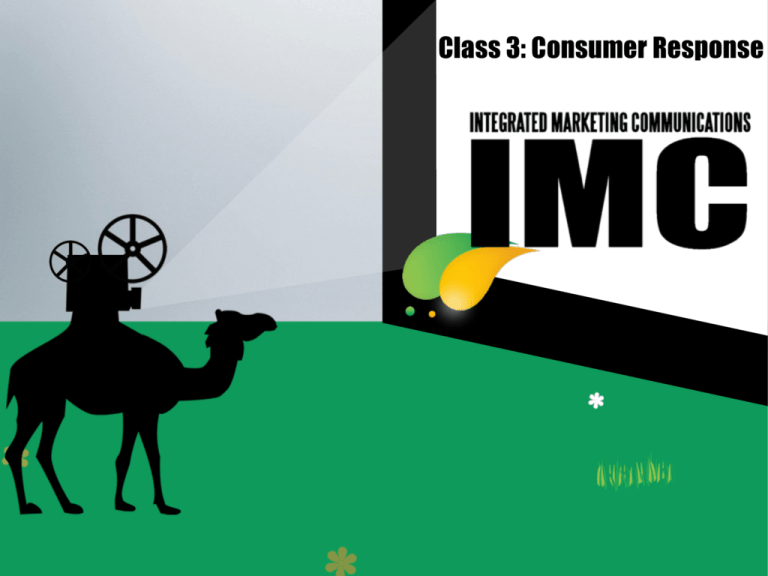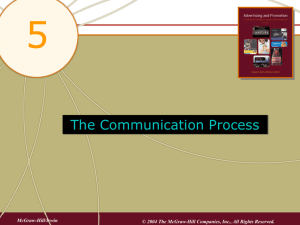Class 3-Consumer Response
advertisement

Class 3: Consumer Response Content Types of consumers How consumers respond to MC messages How brand decision-making works How messages affect decisions Reactions, Responses, and Decision Consumer Behavior Consumer Behavior: How people think about, buy, and use products as a response to marketing communication messages Types of Consumers Prospect Customers Current Customers People who have purchased the brand at least once within a designated period VS People who have not bought the brand but who might be interested in it *Strategy: acquisition *Obj: create brand awareness *Strategy: retention *Obj: achieve top-of-mind + frequent purchases IMPORTANT: it is less costly to maintain existing customers than to acquire new ones Consumers (B2C) People who purchased the product for themselves or for the household. more emotional approach individual decision-making VS Business Buyers (B2B) People who have purchased large quantity of product for company. cognitive approach team decision making large quantities What impacts decision making? Sociocultural Factors culture society (relationship/ companionship) ! Social Class social rankings reference group ! Personal Factors needs/wants Maslow’s hierarchy of needs attitudes, opinions, beliefs *opinion leaders What impacts decision making? Sociocultural Factors Culture: group values based in traditions and distinctive history Ex: Bikini and alcoholic Beverage in Muslim culture ! Society : a group of people who live together and organise their lives as a community (relationship/ friendship/ companionship) ! ! ! Social Class Social rankings: a ranking of people in society Reference group: A group that people love to associate or dissociate with ! Reference Group Play a big role in a decision to purchase products that are publicly used or consumed! Such as clothes, cars, watches, golf clubs, skies, rental car Reference Group Category Personal: family, friends, co-workers Membership: Club, churches, school Experts: Opinion leaders, consultants, leading professional in category Aspirational: Famous entertainers, athletes, politicians Dissociative: Counter-culture, gangs, antisocial people (negative reference group) What impacts decision making? ! Personal Factors needs/wants Maslow’s hierarchy of needs attitudes, opinions, beliefs *opinion leaders How people respond to MC Messages A D I A Hierarchy of Effects Model: AIDA The stages people go through in their decision making process A I D A Attention triggers interest Interest triggers desire Desire triggers action Action purchase, seek info, visit stores, etc Whats wrong with the AIDA model? Think-Feel-Do Model Think-feel-do Response Wheel Remember: the order can vary! Exercise: Think-FeelDo Bradley stopped at the drugstore on the way home. While checking out, he felt like having something sweet, he grabbed a chocolate bar, and ate it immediate. When he arrive home, he looked at package and calculate about calories consumed Kelly, she is highly allergic to peanuts. After school, she stopped by the cafeteria to buy somethings for dinner. Before buying, she had to checked thoroughly about the ingredients to make sure that there was not peanut. Then she bought a pack of bread. Then she felt disappointed as she found it was stale. Think-Feel-Do Model 3 general kinds of responses: think, feel, do The order of our response depends on: product category ! type of buyer ! buying situation ! level of involvement low involvement milk detergents toilet tissue gasoline Products that relatively are without much consideration, and are perceived as car computer watch mobile phone high involvement Products that people perceive among brands and are willing to invest prepurchase decision making energy. They are more expensive consequences; perceived as Elaboration Likelihood Model ELM’s concept: There are 2 paths that customers use in processing information about a product: ! central route peripheral route ! Elaboration Likelihood Model ELM’s concept: There are 2 paths that customers use in processing information about a product: ! central route peripheral route ! When consumers highly involved with the decision; they need to ‘think’ Where Involvement is High Infrequent purchased: • kitchen appliance, pets audio system, exotic food ! Unfamiliar product: • medicine, financial product ! Expensive product: • Furniture, car, insurance, computer Elaboration Likelihood Model 2 ELM’s concept: There are paths that customers use in processing information about a product: ! central route peripheral route ! When consumers less involved with the decision; they need to ‘feel’ uses imagery, emotion, celebrity spokesperson, music... anything that stimulate senses without being informative; triggers association How do people make ˝ buying decisions? Step 1: Recognize a problem or opportunity Evoked Step 2: Evaluate brand alternatives kfast a e r b ome s d e e ss...” a “I n l c e befor set: a grou when a p p of bran erson th ds that c inks of a omes to p r o d mind uct categ person h o ry becau as judge se the d them t o be acce ptable Step 3: Take action Step 3: Evaluate purchase decision Summarizing 4-step decision process 3 paths to a decision... this is a part of Step 2 (Evaluating brand alternatives) Cognitive Path Think-Feel-Do Emotiona l Path Feel-Do-Think/ Do-Feel-Think Habit/Repeat Path Do-Think-Feel Remember: cognitive and emotional approaches are not mutually exclusive How MC influence consumer decisions Ways to Persuade Brand Likability Arguments & Reasons Credibility & Trust Ways to Persuade Brand Likability appeal to the heart ! 2 dimensions: -liking brand -liking message ! helps to develop long-term relationship with customers ! *Persuade people to like your brand first... it will be easier for them to like your message ! Ways to Persuade Brand Credibility & Trust message must be believable how to make your message believable? ! Sources’ credibility ! Opinion leaders! Ways to Persuade Arguments & Reasons cognitive claims ! appeal to people who use cognitive path ! i.e. product demonstration... ‘Seeing is believing’ Final Note: ˝ Communication that aids customers and communicates with them in a personal way is much more persuasive than communication that tries to manipulate them








